Leadership, Change and Consultancy: VUCA Market Impact Report
VerifiedAdded on 2020/05/16
|12
|3092
|53
Report
AI Summary
This report delves into the critical relationship between leadership, change, and consultancy within the context of volatile, uncertain, complex, and ambiguous (VUCA) market conditions. It examines how organizations must adapt their strategies, processes, and culture to remain competitive and responsive to changing customer preferences and global market dynamics. The report explores the driving forces behind organizational change, including market volatility and uncertainty, and provides examples of companies like Coca-Cola and Nokia, illustrating how organizations either thrive or struggle in the face of change. Various models and theories of organizational change and innovation, such as Lewin's three-step model and Kotter's 8-step model, are discussed to provide a framework for understanding and managing change. The report emphasizes the importance of change management, innovation, and adaptability in navigating the complexities of the modern business environment and achieving long-term organizational success. Furthermore, the report highlights the impact of globalization, political forces, and cultural expectations on organizational change, emphasizing the need for businesses to be agile and responsive to maintain relevance and achieve success.
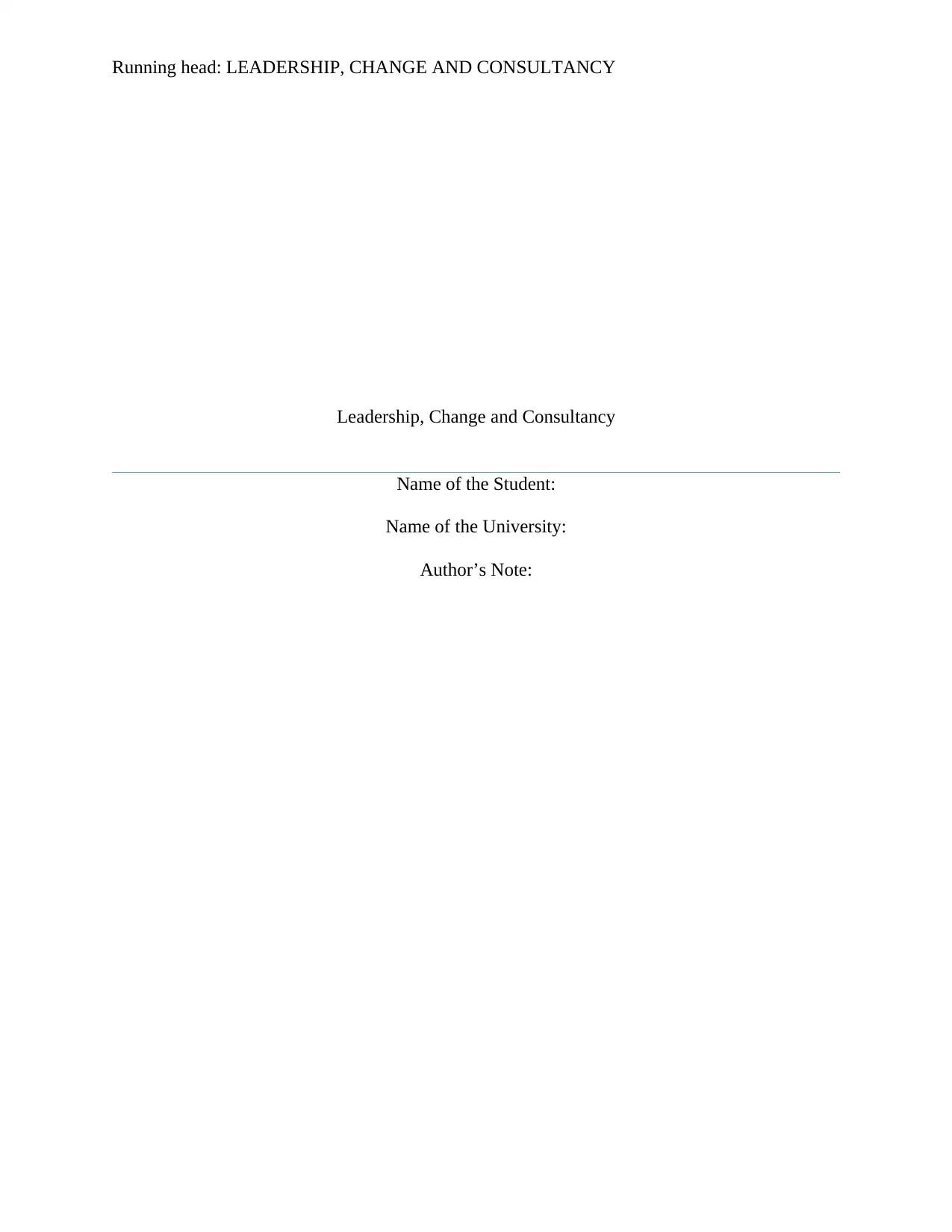
Running head: LEADERSHIP, CHANGE AND CONSULTANCY
Leadership, Change and Consultancy
Name of the Student:
Name of the University:
Author’s Note:
Leadership, Change and Consultancy
Name of the Student:
Name of the University:
Author’s Note:
Paraphrase This Document
Need a fresh take? Get an instant paraphrase of this document with our AI Paraphraser
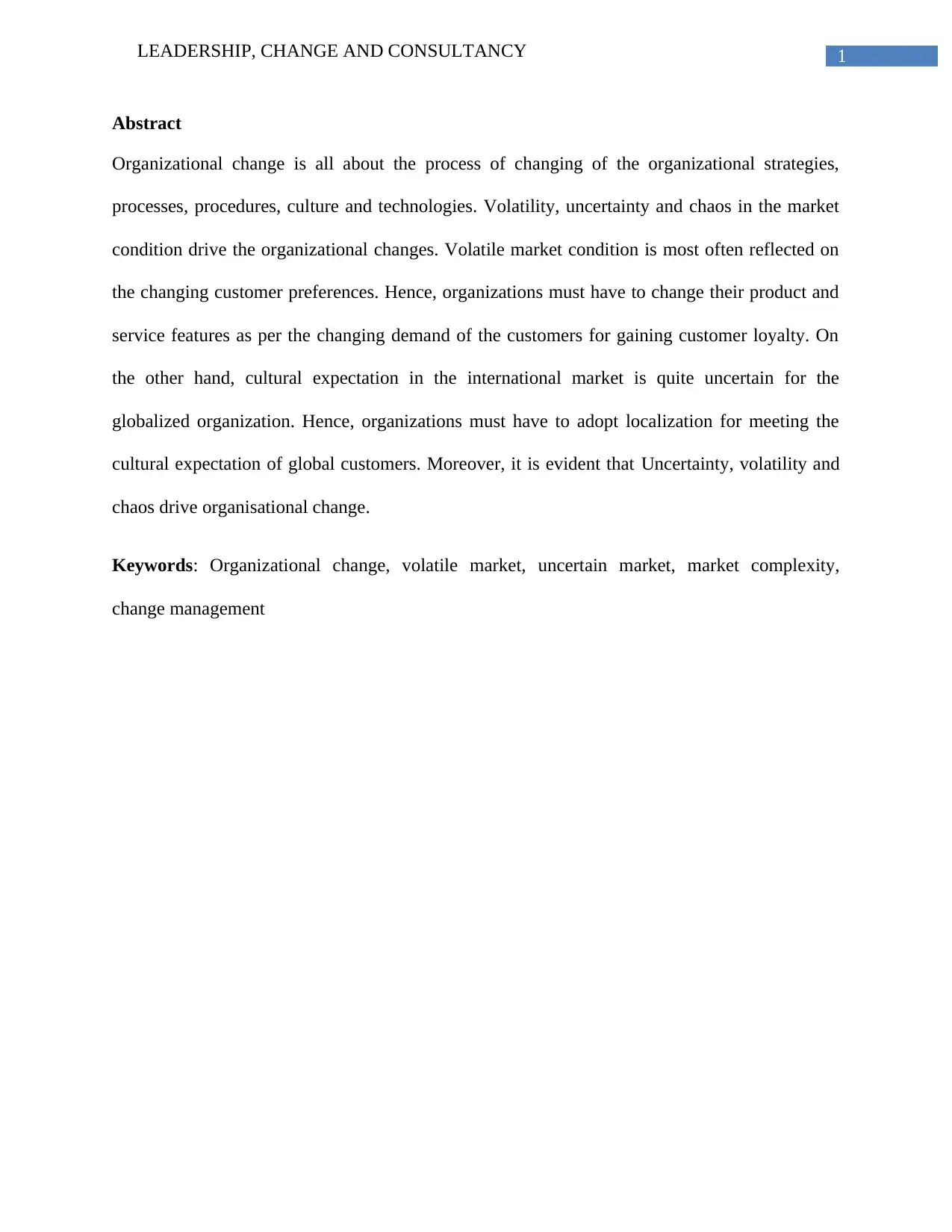
1LEADERSHIP, CHANGE AND CONSULTANCY
Abstract
Organizational change is all about the process of changing of the organizational strategies,
processes, procedures, culture and technologies. Volatility, uncertainty and chaos in the market
condition drive the organizational changes. Volatile market condition is most often reflected on
the changing customer preferences. Hence, organizations must have to change their product and
service features as per the changing demand of the customers for gaining customer loyalty. On
the other hand, cultural expectation in the international market is quite uncertain for the
globalized organization. Hence, organizations must have to adopt localization for meeting the
cultural expectation of global customers. Moreover, it is evident that Uncertainty, volatility and
chaos drive organisational change.
Keywords: Organizational change, volatile market, uncertain market, market complexity,
change management
Abstract
Organizational change is all about the process of changing of the organizational strategies,
processes, procedures, culture and technologies. Volatility, uncertainty and chaos in the market
condition drive the organizational changes. Volatile market condition is most often reflected on
the changing customer preferences. Hence, organizations must have to change their product and
service features as per the changing demand of the customers for gaining customer loyalty. On
the other hand, cultural expectation in the international market is quite uncertain for the
globalized organization. Hence, organizations must have to adopt localization for meeting the
cultural expectation of global customers. Moreover, it is evident that Uncertainty, volatility and
chaos drive organisational change.
Keywords: Organizational change, volatile market, uncertain market, market complexity,
change management
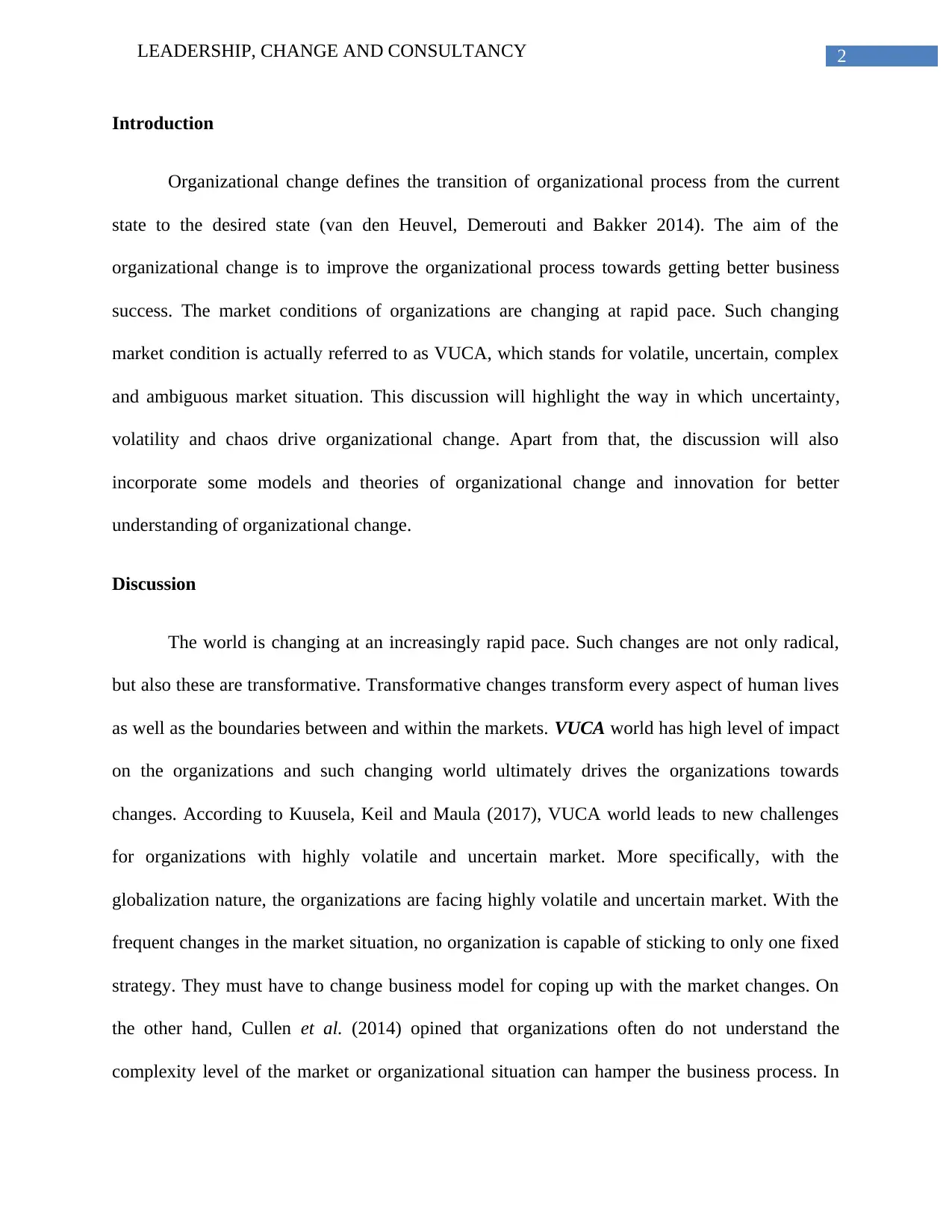
2LEADERSHIP, CHANGE AND CONSULTANCY
Introduction
Organizational change defines the transition of organizational process from the current
state to the desired state (van den Heuvel, Demerouti and Bakker 2014). The aim of the
organizational change is to improve the organizational process towards getting better business
success. The market conditions of organizations are changing at rapid pace. Such changing
market condition is actually referred to as VUCA, which stands for volatile, uncertain, complex
and ambiguous market situation. This discussion will highlight the way in which uncertainty,
volatility and chaos drive organizational change. Apart from that, the discussion will also
incorporate some models and theories of organizational change and innovation for better
understanding of organizational change.
Discussion
The world is changing at an increasingly rapid pace. Such changes are not only radical,
but also these are transformative. Transformative changes transform every aspect of human lives
as well as the boundaries between and within the markets. VUCA world has high level of impact
on the organizations and such changing world ultimately drives the organizations towards
changes. According to Kuusela, Keil and Maula (2017), VUCA world leads to new challenges
for organizations with highly volatile and uncertain market. More specifically, with the
globalization nature, the organizations are facing highly volatile and uncertain market. With the
frequent changes in the market situation, no organization is capable of sticking to only one fixed
strategy. They must have to change business model for coping up with the market changes. On
the other hand, Cullen et al. (2014) opined that organizations often do not understand the
complexity level of the market or organizational situation can hamper the business process. In
Introduction
Organizational change defines the transition of organizational process from the current
state to the desired state (van den Heuvel, Demerouti and Bakker 2014). The aim of the
organizational change is to improve the organizational process towards getting better business
success. The market conditions of organizations are changing at rapid pace. Such changing
market condition is actually referred to as VUCA, which stands for volatile, uncertain, complex
and ambiguous market situation. This discussion will highlight the way in which uncertainty,
volatility and chaos drive organizational change. Apart from that, the discussion will also
incorporate some models and theories of organizational change and innovation for better
understanding of organizational change.
Discussion
The world is changing at an increasingly rapid pace. Such changes are not only radical,
but also these are transformative. Transformative changes transform every aspect of human lives
as well as the boundaries between and within the markets. VUCA world has high level of impact
on the organizations and such changing world ultimately drives the organizations towards
changes. According to Kuusela, Keil and Maula (2017), VUCA world leads to new challenges
for organizations with highly volatile and uncertain market. More specifically, with the
globalization nature, the organizations are facing highly volatile and uncertain market. With the
frequent changes in the market situation, no organization is capable of sticking to only one fixed
strategy. They must have to change business model for coping up with the market changes. On
the other hand, Cullen et al. (2014) opined that organizations often do not understand the
complexity level of the market or organizational situation can hamper the business process. In
⊘ This is a preview!⊘
Do you want full access?
Subscribe today to unlock all pages.

Trusted by 1+ million students worldwide
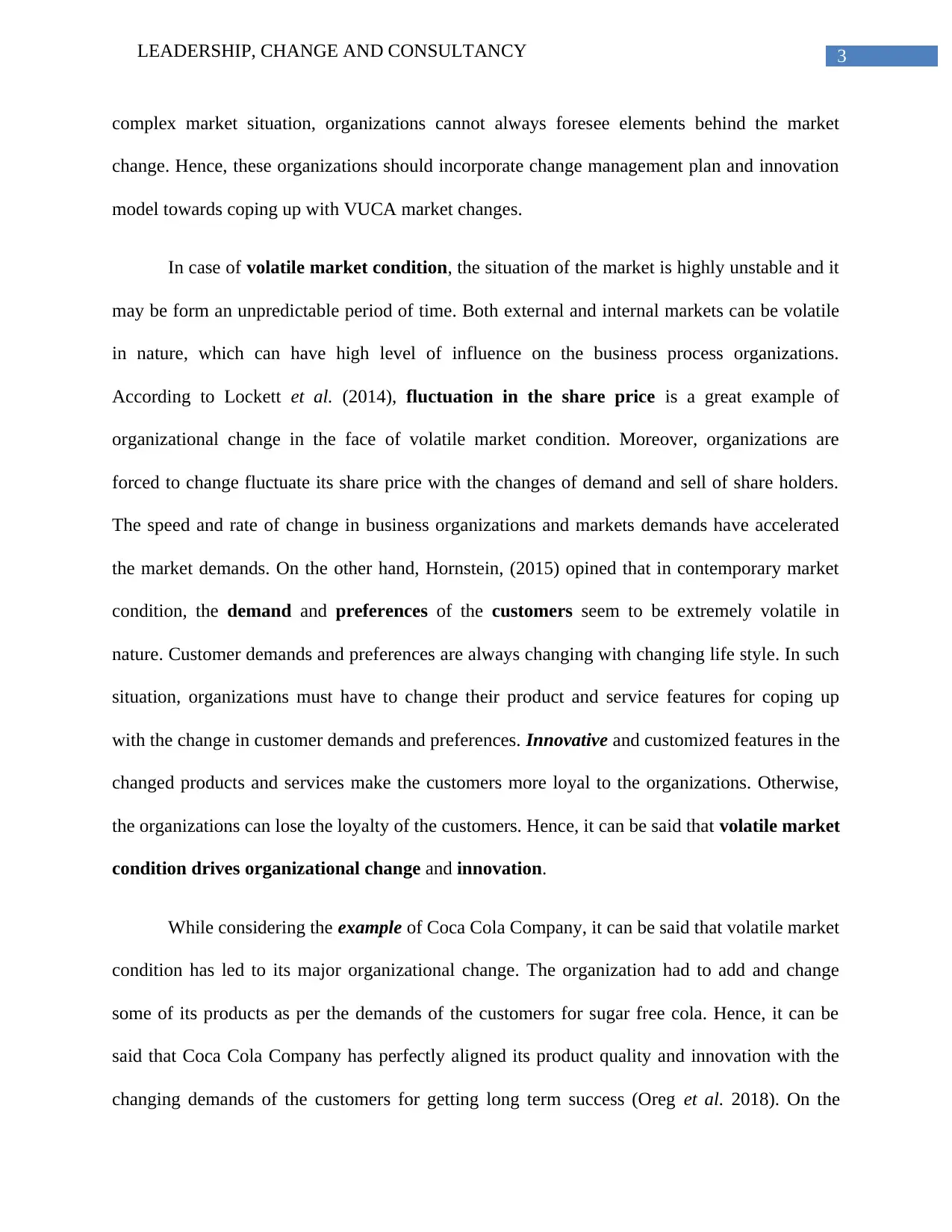
3LEADERSHIP, CHANGE AND CONSULTANCY
complex market situation, organizations cannot always foresee elements behind the market
change. Hence, these organizations should incorporate change management plan and innovation
model towards coping up with VUCA market changes.
In case of volatile market condition, the situation of the market is highly unstable and it
may be form an unpredictable period of time. Both external and internal markets can be volatile
in nature, which can have high level of influence on the business process organizations.
According to Lockett et al. (2014), fluctuation in the share price is a great example of
organizational change in the face of volatile market condition. Moreover, organizations are
forced to change fluctuate its share price with the changes of demand and sell of share holders.
The speed and rate of change in business organizations and markets demands have accelerated
the market demands. On the other hand, Hornstein, (2015) opined that in contemporary market
condition, the demand and preferences of the customers seem to be extremely volatile in
nature. Customer demands and preferences are always changing with changing life style. In such
situation, organizations must have to change their product and service features for coping up
with the change in customer demands and preferences. Innovative and customized features in the
changed products and services make the customers more loyal to the organizations. Otherwise,
the organizations can lose the loyalty of the customers. Hence, it can be said that volatile market
condition drives organizational change and innovation.
While considering the example of Coca Cola Company, it can be said that volatile market
condition has led to its major organizational change. The organization had to add and change
some of its products as per the demands of the customers for sugar free cola. Hence, it can be
said that Coca Cola Company has perfectly aligned its product quality and innovation with the
changing demands of the customers for getting long term success (Oreg et al. 2018). On the
complex market situation, organizations cannot always foresee elements behind the market
change. Hence, these organizations should incorporate change management plan and innovation
model towards coping up with VUCA market changes.
In case of volatile market condition, the situation of the market is highly unstable and it
may be form an unpredictable period of time. Both external and internal markets can be volatile
in nature, which can have high level of influence on the business process organizations.
According to Lockett et al. (2014), fluctuation in the share price is a great example of
organizational change in the face of volatile market condition. Moreover, organizations are
forced to change fluctuate its share price with the changes of demand and sell of share holders.
The speed and rate of change in business organizations and markets demands have accelerated
the market demands. On the other hand, Hornstein, (2015) opined that in contemporary market
condition, the demand and preferences of the customers seem to be extremely volatile in
nature. Customer demands and preferences are always changing with changing life style. In such
situation, organizations must have to change their product and service features for coping up
with the change in customer demands and preferences. Innovative and customized features in the
changed products and services make the customers more loyal to the organizations. Otherwise,
the organizations can lose the loyalty of the customers. Hence, it can be said that volatile market
condition drives organizational change and innovation.
While considering the example of Coca Cola Company, it can be said that volatile market
condition has led to its major organizational change. The organization had to add and change
some of its products as per the demands of the customers for sugar free cola. Hence, it can be
said that Coca Cola Company has perfectly aligned its product quality and innovation with the
changing demands of the customers for getting long term success (Oreg et al. 2018). On the
Paraphrase This Document
Need a fresh take? Get an instant paraphrase of this document with our AI Paraphraser

4LEADERSHIP, CHANGE AND CONSULTANCY
other hand, while taking the example of Nokia, the organization had become failed to cope up
with the changing demand of the customers for android operating system. It had not changed its
operating system and remained stick with its old windows operating system. Ultimately, the
customers started to shift to other organization for fulfilling their changing needs, which
ultimately causes disruption of the business of Nokia (Cordery et al. 2015).
In case of uncertain market condition, uncertainty is all around the business
organizations. In such difficult time, it is extremely necessary to be clear on present for
accurately predicting the future outcome. However, uncertainty is always associated with lack of
predictability of the issues and events, which can ruin the success of business. According to
Cameron and McNaughtan (2014), sudden launch of similar or even superior products and
offerings by the competitors can be an uncertainty for the organizations. New and innovative
products offered by the competitors often seem to be a threat for a particular organization. In
such situation, the organization should change their business model through launching their
unique products and service for beating the competitive of the competitors. On the other hand,
Nohe and Michaelis (2016) opined that political forces have also direct bearing on the
functioning of business organization. Political forces like the ideologies of the parties,
Government decision, tax policy and political stability seem to be quite uncertain for
organizations. Changes in political frame force organizations to change their business model for
coping up with the changes political frame. Organizations always have to be adaptive with the
changing government decisions and policies for their long term sustainability. Hence, it can be
said that uncertain
While considering the example of Tesco Plc, it can be seen that the organization always
changes their product quality and discount policy as per the changes of their competitors
other hand, while taking the example of Nokia, the organization had become failed to cope up
with the changing demand of the customers for android operating system. It had not changed its
operating system and remained stick with its old windows operating system. Ultimately, the
customers started to shift to other organization for fulfilling their changing needs, which
ultimately causes disruption of the business of Nokia (Cordery et al. 2015).
In case of uncertain market condition, uncertainty is all around the business
organizations. In such difficult time, it is extremely necessary to be clear on present for
accurately predicting the future outcome. However, uncertainty is always associated with lack of
predictability of the issues and events, which can ruin the success of business. According to
Cameron and McNaughtan (2014), sudden launch of similar or even superior products and
offerings by the competitors can be an uncertainty for the organizations. New and innovative
products offered by the competitors often seem to be a threat for a particular organization. In
such situation, the organization should change their business model through launching their
unique products and service for beating the competitive of the competitors. On the other hand,
Nohe and Michaelis (2016) opined that political forces have also direct bearing on the
functioning of business organization. Political forces like the ideologies of the parties,
Government decision, tax policy and political stability seem to be quite uncertain for
organizations. Changes in political frame force organizations to change their business model for
coping up with the changes political frame. Organizations always have to be adaptive with the
changing government decisions and policies for their long term sustainability. Hence, it can be
said that uncertain
While considering the example of Tesco Plc, it can be seen that the organization always
changes their product quality and discount policy as per the changes of their competitors
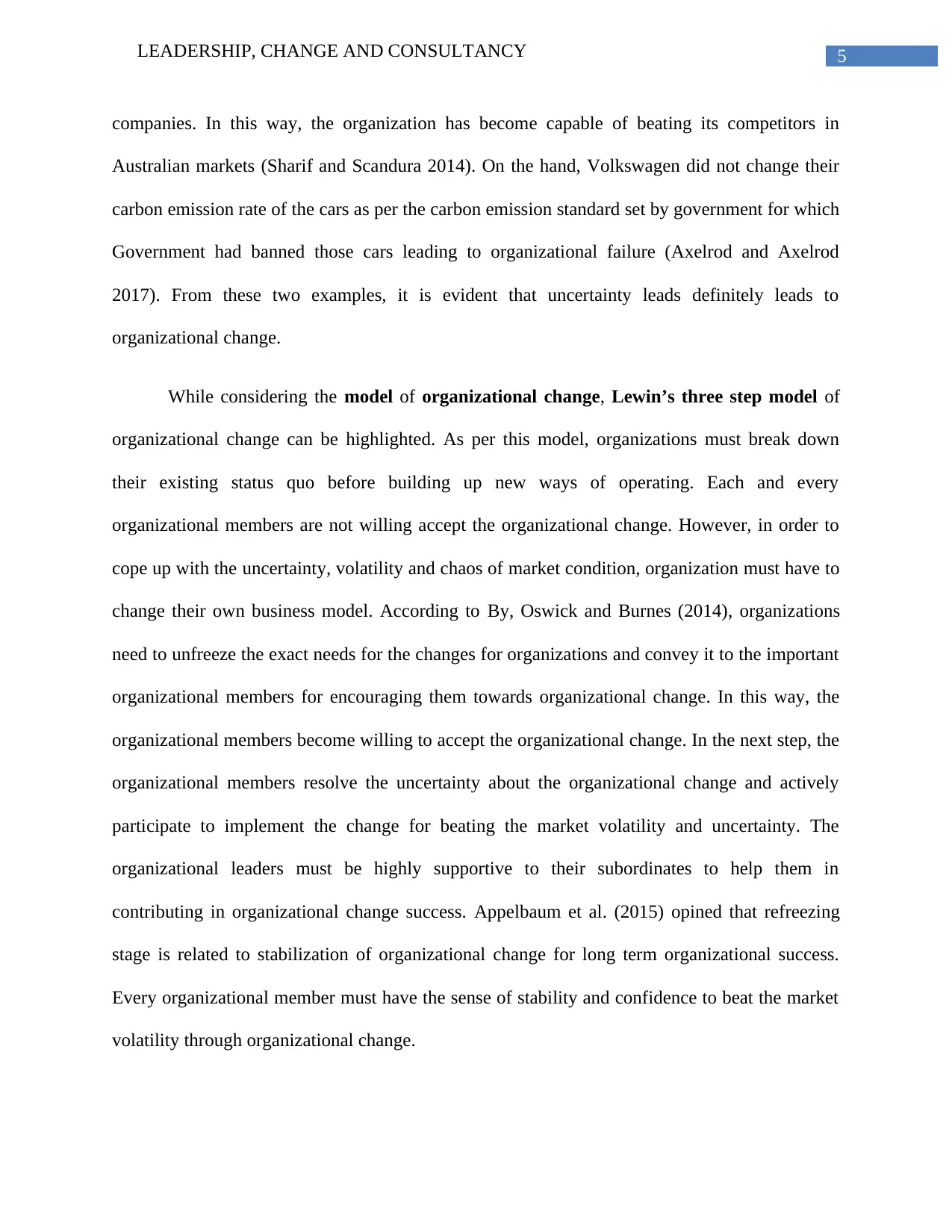
5LEADERSHIP, CHANGE AND CONSULTANCY
companies. In this way, the organization has become capable of beating its competitors in
Australian markets (Sharif and Scandura 2014). On the hand, Volkswagen did not change their
carbon emission rate of the cars as per the carbon emission standard set by government for which
Government had banned those cars leading to organizational failure (Axelrod and Axelrod
2017). From these two examples, it is evident that uncertainty leads definitely leads to
organizational change.
While considering the model of organizational change, Lewin’s three step model of
organizational change can be highlighted. As per this model, organizations must break down
their existing status quo before building up new ways of operating. Each and every
organizational members are not willing accept the organizational change. However, in order to
cope up with the uncertainty, volatility and chaos of market condition, organization must have to
change their own business model. According to By, Oswick and Burnes (2014), organizations
need to unfreeze the exact needs for the changes for organizations and convey it to the important
organizational members for encouraging them towards organizational change. In this way, the
organizational members become willing to accept the organizational change. In the next step, the
organizational members resolve the uncertainty about the organizational change and actively
participate to implement the change for beating the market volatility and uncertainty. The
organizational leaders must be highly supportive to their subordinates to help them in
contributing in organizational change success. Appelbaum et al. (2015) opined that refreezing
stage is related to stabilization of organizational change for long term organizational success.
Every organizational member must have the sense of stability and confidence to beat the market
volatility through organizational change.
companies. In this way, the organization has become capable of beating its competitors in
Australian markets (Sharif and Scandura 2014). On the hand, Volkswagen did not change their
carbon emission rate of the cars as per the carbon emission standard set by government for which
Government had banned those cars leading to organizational failure (Axelrod and Axelrod
2017). From these two examples, it is evident that uncertainty leads definitely leads to
organizational change.
While considering the model of organizational change, Lewin’s three step model of
organizational change can be highlighted. As per this model, organizations must break down
their existing status quo before building up new ways of operating. Each and every
organizational members are not willing accept the organizational change. However, in order to
cope up with the uncertainty, volatility and chaos of market condition, organization must have to
change their own business model. According to By, Oswick and Burnes (2014), organizations
need to unfreeze the exact needs for the changes for organizations and convey it to the important
organizational members for encouraging them towards organizational change. In this way, the
organizational members become willing to accept the organizational change. In the next step, the
organizational members resolve the uncertainty about the organizational change and actively
participate to implement the change for beating the market volatility and uncertainty. The
organizational leaders must be highly supportive to their subordinates to help them in
contributing in organizational change success. Appelbaum et al. (2015) opined that refreezing
stage is related to stabilization of organizational change for long term organizational success.
Every organizational member must have the sense of stability and confidence to beat the market
volatility through organizational change.
⊘ This is a preview!⊘
Do you want full access?
Subscribe today to unlock all pages.

Trusted by 1+ million students worldwide
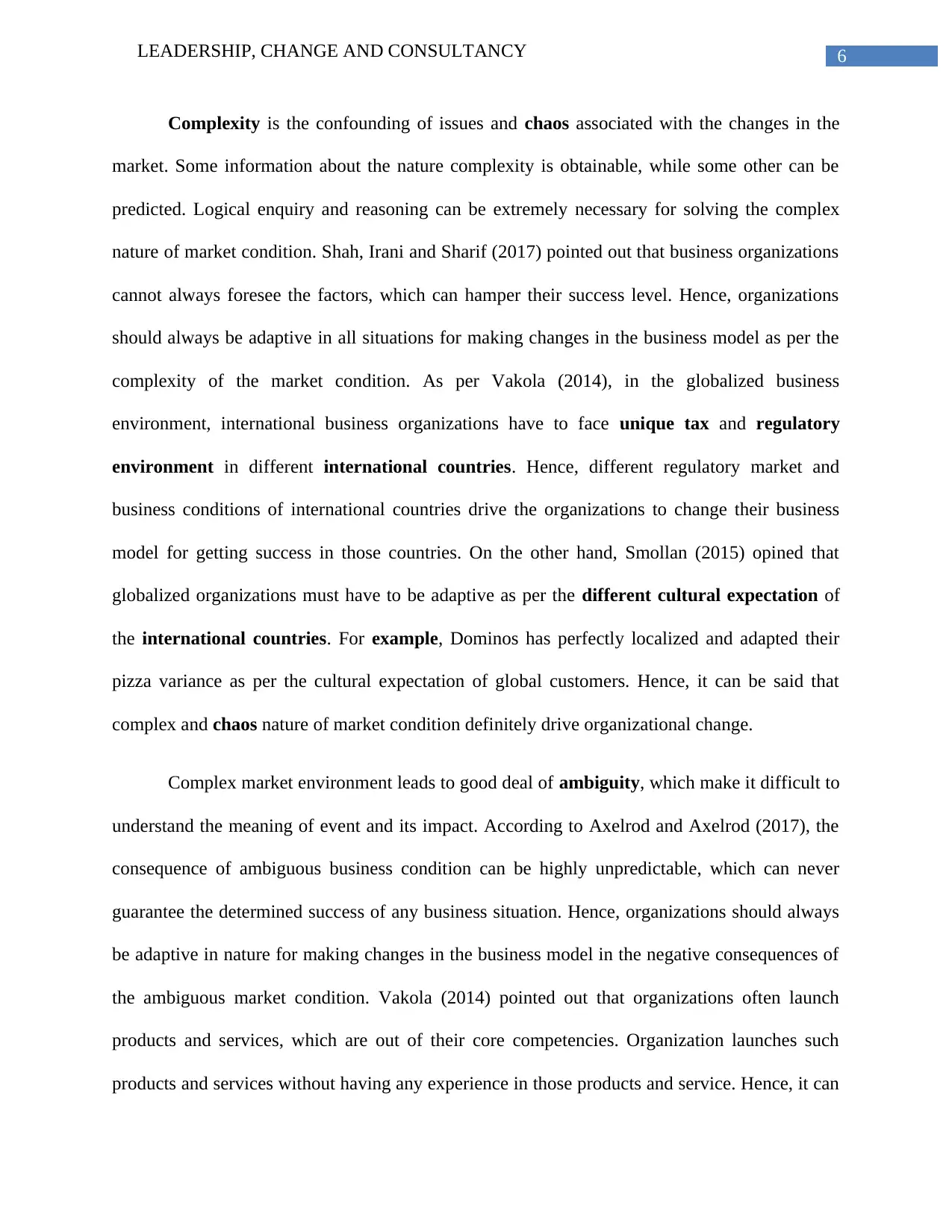
6LEADERSHIP, CHANGE AND CONSULTANCY
Complexity is the confounding of issues and chaos associated with the changes in the
market. Some information about the nature complexity is obtainable, while some other can be
predicted. Logical enquiry and reasoning can be extremely necessary for solving the complex
nature of market condition. Shah, Irani and Sharif (2017) pointed out that business organizations
cannot always foresee the factors, which can hamper their success level. Hence, organizations
should always be adaptive in all situations for making changes in the business model as per the
complexity of the market condition. As per Vakola (2014), in the globalized business
environment, international business organizations have to face unique tax and regulatory
environment in different international countries. Hence, different regulatory market and
business conditions of international countries drive the organizations to change their business
model for getting success in those countries. On the other hand, Smollan (2015) opined that
globalized organizations must have to be adaptive as per the different cultural expectation of
the international countries. For example, Dominos has perfectly localized and adapted their
pizza variance as per the cultural expectation of global customers. Hence, it can be said that
complex and chaos nature of market condition definitely drive organizational change.
Complex market environment leads to good deal of ambiguity, which make it difficult to
understand the meaning of event and its impact. According to Axelrod and Axelrod (2017), the
consequence of ambiguous business condition can be highly unpredictable, which can never
guarantee the determined success of any business situation. Hence, organizations should always
be adaptive in nature for making changes in the business model in the negative consequences of
the ambiguous market condition. Vakola (2014) pointed out that organizations often launch
products and services, which are out of their core competencies. Organization launches such
products and services without having any experience in those products and service. Hence, it can
Complexity is the confounding of issues and chaos associated with the changes in the
market. Some information about the nature complexity is obtainable, while some other can be
predicted. Logical enquiry and reasoning can be extremely necessary for solving the complex
nature of market condition. Shah, Irani and Sharif (2017) pointed out that business organizations
cannot always foresee the factors, which can hamper their success level. Hence, organizations
should always be adaptive in all situations for making changes in the business model as per the
complexity of the market condition. As per Vakola (2014), in the globalized business
environment, international business organizations have to face unique tax and regulatory
environment in different international countries. Hence, different regulatory market and
business conditions of international countries drive the organizations to change their business
model for getting success in those countries. On the other hand, Smollan (2015) opined that
globalized organizations must have to be adaptive as per the different cultural expectation of
the international countries. For example, Dominos has perfectly localized and adapted their
pizza variance as per the cultural expectation of global customers. Hence, it can be said that
complex and chaos nature of market condition definitely drive organizational change.
Complex market environment leads to good deal of ambiguity, which make it difficult to
understand the meaning of event and its impact. According to Axelrod and Axelrod (2017), the
consequence of ambiguous business condition can be highly unpredictable, which can never
guarantee the determined success of any business situation. Hence, organizations should always
be adaptive in nature for making changes in the business model in the negative consequences of
the ambiguous market condition. Vakola (2014) pointed out that organizations often launch
products and services, which are out of their core competencies. Organization launches such
products and services without having any experience in those products and service. Hence, it can
Paraphrase This Document
Need a fresh take? Get an instant paraphrase of this document with our AI Paraphraser
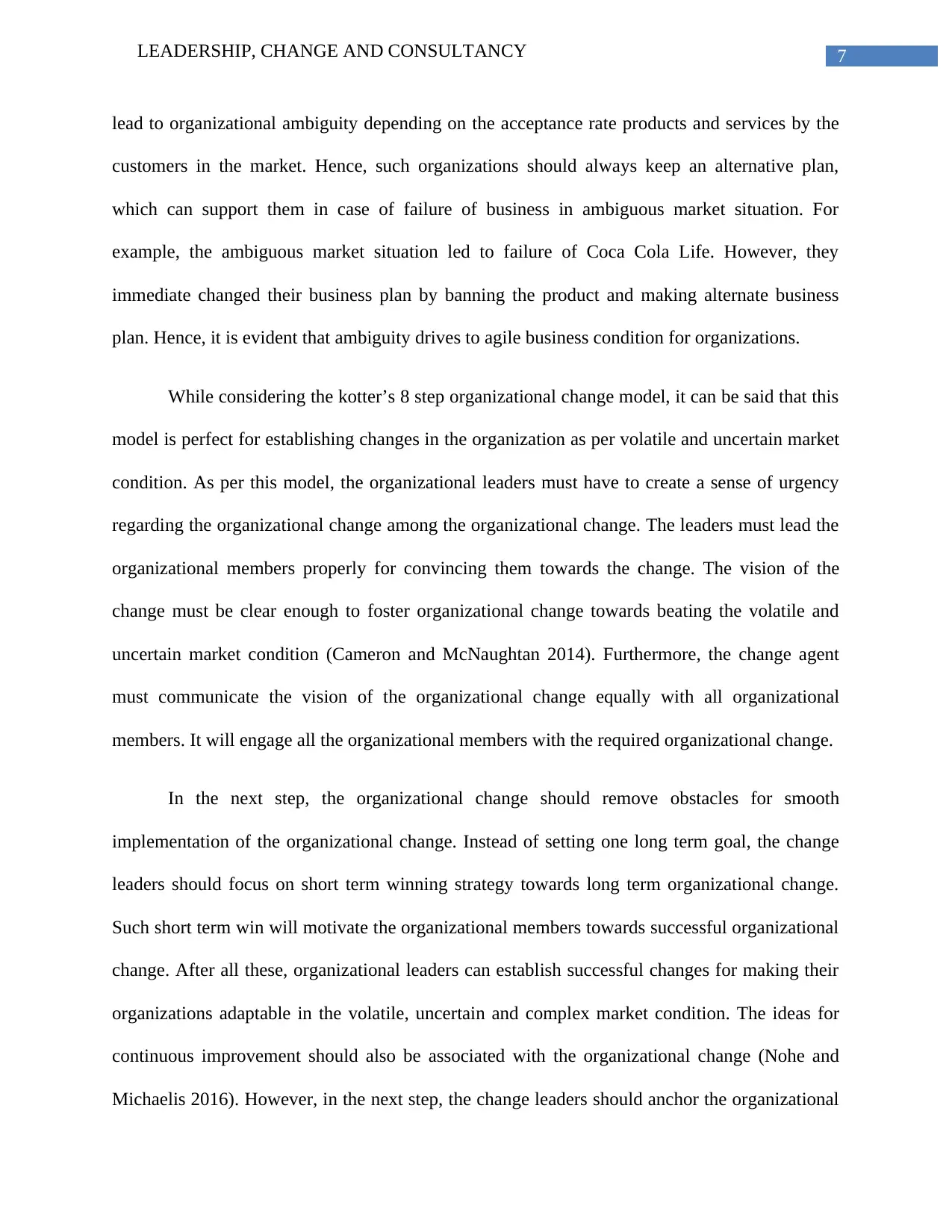
7LEADERSHIP, CHANGE AND CONSULTANCY
lead to organizational ambiguity depending on the acceptance rate products and services by the
customers in the market. Hence, such organizations should always keep an alternative plan,
which can support them in case of failure of business in ambiguous market situation. For
example, the ambiguous market situation led to failure of Coca Cola Life. However, they
immediate changed their business plan by banning the product and making alternate business
plan. Hence, it is evident that ambiguity drives to agile business condition for organizations.
While considering the kotter’s 8 step organizational change model, it can be said that this
model is perfect for establishing changes in the organization as per volatile and uncertain market
condition. As per this model, the organizational leaders must have to create a sense of urgency
regarding the organizational change among the organizational change. The leaders must lead the
organizational members properly for convincing them towards the change. The vision of the
change must be clear enough to foster organizational change towards beating the volatile and
uncertain market condition (Cameron and McNaughtan 2014). Furthermore, the change agent
must communicate the vision of the organizational change equally with all organizational
members. It will engage all the organizational members with the required organizational change.
In the next step, the organizational change should remove obstacles for smooth
implementation of the organizational change. Instead of setting one long term goal, the change
leaders should focus on short term winning strategy towards long term organizational change.
Such short term win will motivate the organizational members towards successful organizational
change. After all these, organizational leaders can establish successful changes for making their
organizations adaptable in the volatile, uncertain and complex market condition. The ideas for
continuous improvement should also be associated with the organizational change (Nohe and
Michaelis 2016). However, in the next step, the change leaders should anchor the organizational
lead to organizational ambiguity depending on the acceptance rate products and services by the
customers in the market. Hence, such organizations should always keep an alternative plan,
which can support them in case of failure of business in ambiguous market situation. For
example, the ambiguous market situation led to failure of Coca Cola Life. However, they
immediate changed their business plan by banning the product and making alternate business
plan. Hence, it is evident that ambiguity drives to agile business condition for organizations.
While considering the kotter’s 8 step organizational change model, it can be said that this
model is perfect for establishing changes in the organization as per volatile and uncertain market
condition. As per this model, the organizational leaders must have to create a sense of urgency
regarding the organizational change among the organizational change. The leaders must lead the
organizational members properly for convincing them towards the change. The vision of the
change must be clear enough to foster organizational change towards beating the volatile and
uncertain market condition (Cameron and McNaughtan 2014). Furthermore, the change agent
must communicate the vision of the organizational change equally with all organizational
members. It will engage all the organizational members with the required organizational change.
In the next step, the organizational change should remove obstacles for smooth
implementation of the organizational change. Instead of setting one long term goal, the change
leaders should focus on short term winning strategy towards long term organizational change.
Such short term win will motivate the organizational members towards successful organizational
change. After all these, organizational leaders can establish successful changes for making their
organizations adaptable in the volatile, uncertain and complex market condition. The ideas for
continuous improvement should also be associated with the organizational change (Nohe and
Michaelis 2016). However, in the next step, the change leaders should anchor the organizational
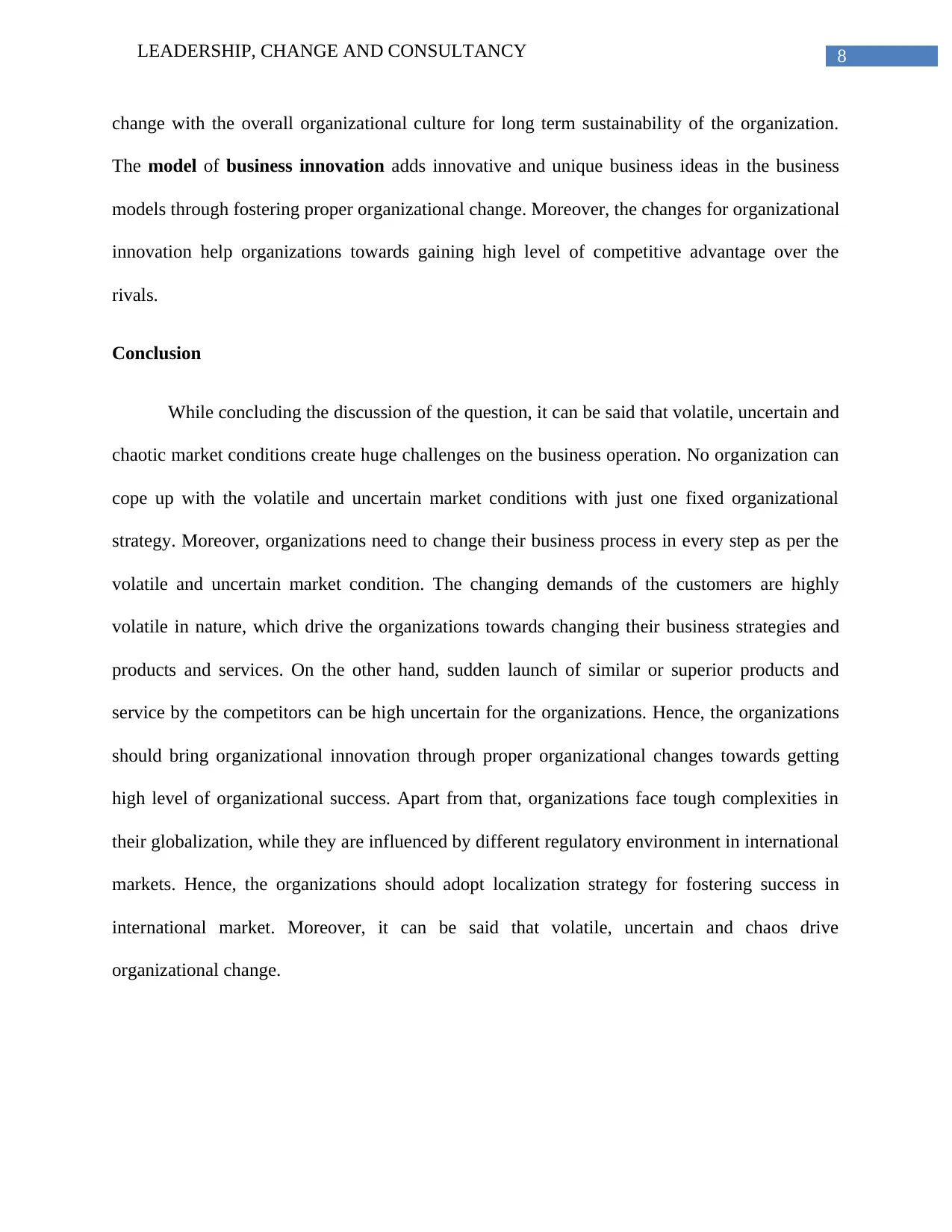
8LEADERSHIP, CHANGE AND CONSULTANCY
change with the overall organizational culture for long term sustainability of the organization.
The model of business innovation adds innovative and unique business ideas in the business
models through fostering proper organizational change. Moreover, the changes for organizational
innovation help organizations towards gaining high level of competitive advantage over the
rivals.
Conclusion
While concluding the discussion of the question, it can be said that volatile, uncertain and
chaotic market conditions create huge challenges on the business operation. No organization can
cope up with the volatile and uncertain market conditions with just one fixed organizational
strategy. Moreover, organizations need to change their business process in every step as per the
volatile and uncertain market condition. The changing demands of the customers are highly
volatile in nature, which drive the organizations towards changing their business strategies and
products and services. On the other hand, sudden launch of similar or superior products and
service by the competitors can be high uncertain for the organizations. Hence, the organizations
should bring organizational innovation through proper organizational changes towards getting
high level of organizational success. Apart from that, organizations face tough complexities in
their globalization, while they are influenced by different regulatory environment in international
markets. Hence, the organizations should adopt localization strategy for fostering success in
international market. Moreover, it can be said that volatile, uncertain and chaos drive
organizational change.
change with the overall organizational culture for long term sustainability of the organization.
The model of business innovation adds innovative and unique business ideas in the business
models through fostering proper organizational change. Moreover, the changes for organizational
innovation help organizations towards gaining high level of competitive advantage over the
rivals.
Conclusion
While concluding the discussion of the question, it can be said that volatile, uncertain and
chaotic market conditions create huge challenges on the business operation. No organization can
cope up with the volatile and uncertain market conditions with just one fixed organizational
strategy. Moreover, organizations need to change their business process in every step as per the
volatile and uncertain market condition. The changing demands of the customers are highly
volatile in nature, which drive the organizations towards changing their business strategies and
products and services. On the other hand, sudden launch of similar or superior products and
service by the competitors can be high uncertain for the organizations. Hence, the organizations
should bring organizational innovation through proper organizational changes towards getting
high level of organizational success. Apart from that, organizations face tough complexities in
their globalization, while they are influenced by different regulatory environment in international
markets. Hence, the organizations should adopt localization strategy for fostering success in
international market. Moreover, it can be said that volatile, uncertain and chaos drive
organizational change.
⊘ This is a preview!⊘
Do you want full access?
Subscribe today to unlock all pages.

Trusted by 1+ million students worldwide
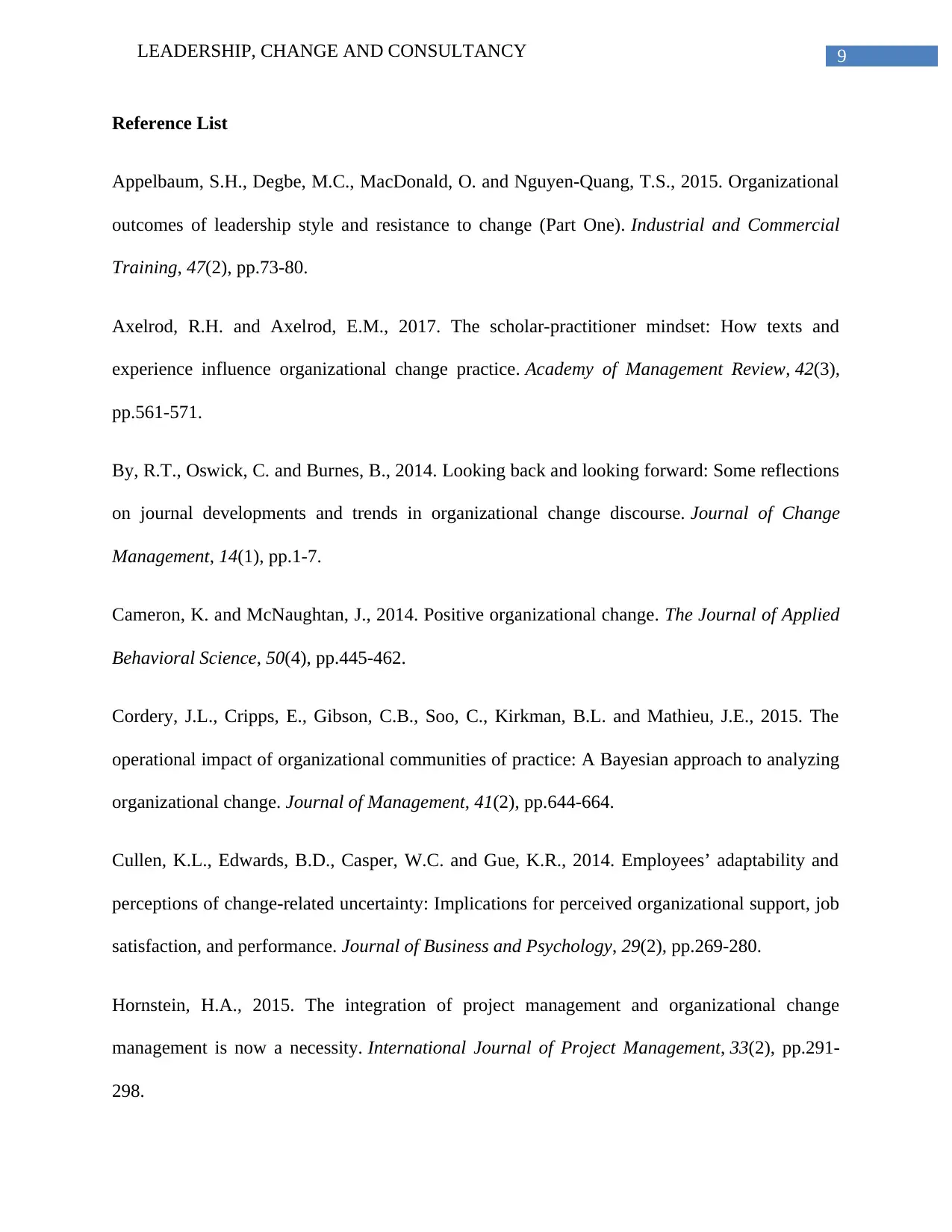
9LEADERSHIP, CHANGE AND CONSULTANCY
Reference List
Appelbaum, S.H., Degbe, M.C., MacDonald, O. and Nguyen-Quang, T.S., 2015. Organizational
outcomes of leadership style and resistance to change (Part One). Industrial and Commercial
Training, 47(2), pp.73-80.
Axelrod, R.H. and Axelrod, E.M., 2017. The scholar-practitioner mindset: How texts and
experience influence organizational change practice. Academy of Management Review, 42(3),
pp.561-571.
By, R.T., Oswick, C. and Burnes, B., 2014. Looking back and looking forward: Some reflections
on journal developments and trends in organizational change discourse. Journal of Change
Management, 14(1), pp.1-7.
Cameron, K. and McNaughtan, J., 2014. Positive organizational change. The Journal of Applied
Behavioral Science, 50(4), pp.445-462.
Cordery, J.L., Cripps, E., Gibson, C.B., Soo, C., Kirkman, B.L. and Mathieu, J.E., 2015. The
operational impact of organizational communities of practice: A Bayesian approach to analyzing
organizational change. Journal of Management, 41(2), pp.644-664.
Cullen, K.L., Edwards, B.D., Casper, W.C. and Gue, K.R., 2014. Employees’ adaptability and
perceptions of change-related uncertainty: Implications for perceived organizational support, job
satisfaction, and performance. Journal of Business and Psychology, 29(2), pp.269-280.
Hornstein, H.A., 2015. The integration of project management and organizational change
management is now a necessity. International Journal of Project Management, 33(2), pp.291-
298.
Reference List
Appelbaum, S.H., Degbe, M.C., MacDonald, O. and Nguyen-Quang, T.S., 2015. Organizational
outcomes of leadership style and resistance to change (Part One). Industrial and Commercial
Training, 47(2), pp.73-80.
Axelrod, R.H. and Axelrod, E.M., 2017. The scholar-practitioner mindset: How texts and
experience influence organizational change practice. Academy of Management Review, 42(3),
pp.561-571.
By, R.T., Oswick, C. and Burnes, B., 2014. Looking back and looking forward: Some reflections
on journal developments and trends in organizational change discourse. Journal of Change
Management, 14(1), pp.1-7.
Cameron, K. and McNaughtan, J., 2014. Positive organizational change. The Journal of Applied
Behavioral Science, 50(4), pp.445-462.
Cordery, J.L., Cripps, E., Gibson, C.B., Soo, C., Kirkman, B.L. and Mathieu, J.E., 2015. The
operational impact of organizational communities of practice: A Bayesian approach to analyzing
organizational change. Journal of Management, 41(2), pp.644-664.
Cullen, K.L., Edwards, B.D., Casper, W.C. and Gue, K.R., 2014. Employees’ adaptability and
perceptions of change-related uncertainty: Implications for perceived organizational support, job
satisfaction, and performance. Journal of Business and Psychology, 29(2), pp.269-280.
Hornstein, H.A., 2015. The integration of project management and organizational change
management is now a necessity. International Journal of Project Management, 33(2), pp.291-
298.
Paraphrase This Document
Need a fresh take? Get an instant paraphrase of this document with our AI Paraphraser
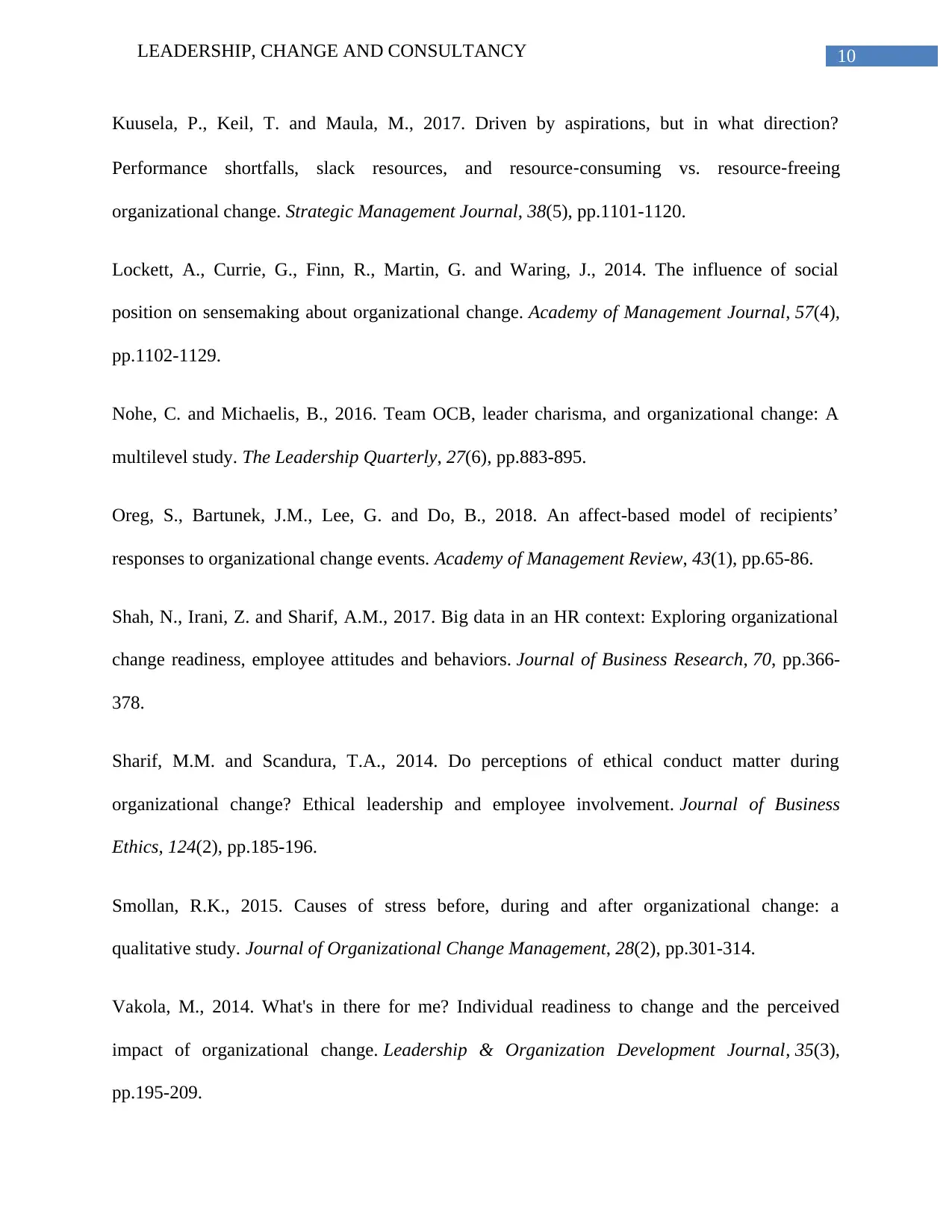
10LEADERSHIP, CHANGE AND CONSULTANCY
Kuusela, P., Keil, T. and Maula, M., 2017. Driven by aspirations, but in what direction?
Performance shortfalls, slack resources, and resource‐consuming vs. resource‐freeing
organizational change. Strategic Management Journal, 38(5), pp.1101-1120.
Lockett, A., Currie, G., Finn, R., Martin, G. and Waring, J., 2014. The influence of social
position on sensemaking about organizational change. Academy of Management Journal, 57(4),
pp.1102-1129.
Nohe, C. and Michaelis, B., 2016. Team OCB, leader charisma, and organizational change: A
multilevel study. The Leadership Quarterly, 27(6), pp.883-895.
Oreg, S., Bartunek, J.M., Lee, G. and Do, B., 2018. An affect-based model of recipients’
responses to organizational change events. Academy of Management Review, 43(1), pp.65-86.
Shah, N., Irani, Z. and Sharif, A.M., 2017. Big data in an HR context: Exploring organizational
change readiness, employee attitudes and behaviors. Journal of Business Research, 70, pp.366-
378.
Sharif, M.M. and Scandura, T.A., 2014. Do perceptions of ethical conduct matter during
organizational change? Ethical leadership and employee involvement. Journal of Business
Ethics, 124(2), pp.185-196.
Smollan, R.K., 2015. Causes of stress before, during and after organizational change: a
qualitative study. Journal of Organizational Change Management, 28(2), pp.301-314.
Vakola, M., 2014. What's in there for me? Individual readiness to change and the perceived
impact of organizational change. Leadership & Organization Development Journal, 35(3),
pp.195-209.
Kuusela, P., Keil, T. and Maula, M., 2017. Driven by aspirations, but in what direction?
Performance shortfalls, slack resources, and resource‐consuming vs. resource‐freeing
organizational change. Strategic Management Journal, 38(5), pp.1101-1120.
Lockett, A., Currie, G., Finn, R., Martin, G. and Waring, J., 2014. The influence of social
position on sensemaking about organizational change. Academy of Management Journal, 57(4),
pp.1102-1129.
Nohe, C. and Michaelis, B., 2016. Team OCB, leader charisma, and organizational change: A
multilevel study. The Leadership Quarterly, 27(6), pp.883-895.
Oreg, S., Bartunek, J.M., Lee, G. and Do, B., 2018. An affect-based model of recipients’
responses to organizational change events. Academy of Management Review, 43(1), pp.65-86.
Shah, N., Irani, Z. and Sharif, A.M., 2017. Big data in an HR context: Exploring organizational
change readiness, employee attitudes and behaviors. Journal of Business Research, 70, pp.366-
378.
Sharif, M.M. and Scandura, T.A., 2014. Do perceptions of ethical conduct matter during
organizational change? Ethical leadership and employee involvement. Journal of Business
Ethics, 124(2), pp.185-196.
Smollan, R.K., 2015. Causes of stress before, during and after organizational change: a
qualitative study. Journal of Organizational Change Management, 28(2), pp.301-314.
Vakola, M., 2014. What's in there for me? Individual readiness to change and the perceived
impact of organizational change. Leadership & Organization Development Journal, 35(3),
pp.195-209.
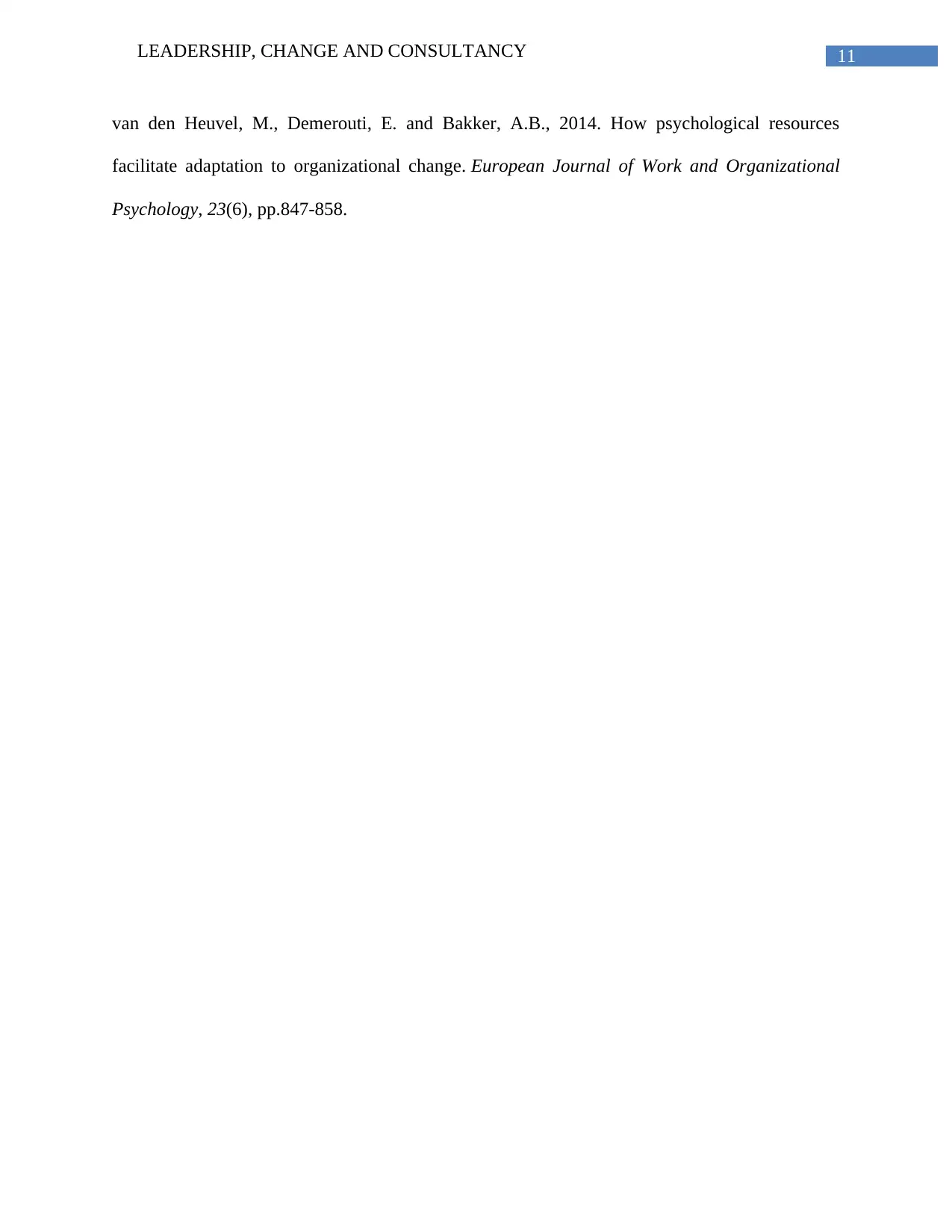
11LEADERSHIP, CHANGE AND CONSULTANCY
van den Heuvel, M., Demerouti, E. and Bakker, A.B., 2014. How psychological resources
facilitate adaptation to organizational change. European Journal of Work and Organizational
Psychology, 23(6), pp.847-858.
van den Heuvel, M., Demerouti, E. and Bakker, A.B., 2014. How psychological resources
facilitate adaptation to organizational change. European Journal of Work and Organizational
Psychology, 23(6), pp.847-858.
⊘ This is a preview!⊘
Do you want full access?
Subscribe today to unlock all pages.

Trusted by 1+ million students worldwide
1 out of 12
Related Documents
Your All-in-One AI-Powered Toolkit for Academic Success.
+13062052269
info@desklib.com
Available 24*7 on WhatsApp / Email
![[object Object]](/_next/static/media/star-bottom.7253800d.svg)
Unlock your academic potential
Copyright © 2020–2025 A2Z Services. All Rights Reserved. Developed and managed by ZUCOL.




